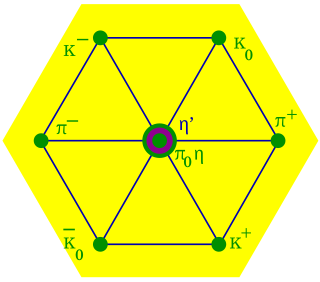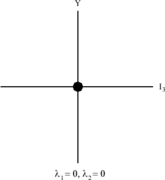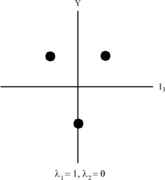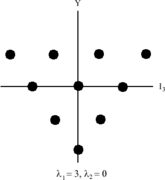
In particle physics, a baryon is a type of composite subatomic particle that contains an odd number of valence quarks, conventionally three. Baryons belong to the hadron family of particles; hadrons are composed of quarks. Baryons are also classified as fermions because they have half-integer spin.

In particle physics, a meson is a type of hadronic subatomic particle composed of an equal number of quarks and antiquarks, usually one of each, bound together by the strong interaction. Because mesons are composed of quark subparticles, they have a meaningful physical size, a diameter of roughly one femtometre (10−15 m), which is about 0.6 times the size of a proton or neutron. All mesons are unstable, with the longest-lived lasting for only a few tenths of a nanosecond. Heavier mesons decay to lighter mesons and ultimately to stable electrons, neutrinos and photons.

In physics and chemistry, a nucleon is either a proton or a neutron, considered in its role as a component of an atomic nucleus. The number of nucleons in a nucleus defines the atom's mass number.

A quark is a type of elementary particle and a fundamental constituent of matter. Quarks combine to form composite particles called hadrons, the most stable of which are protons and neutrons, the components of atomic nuclei. All commonly observable matter is composed of up quarks, down quarks and electrons. Owing to a phenomenon known as color confinement, quarks are never found in isolation; they can be found only within hadrons, which include baryons and mesons, or in quark–gluon plasmas. For this reason, much of what is known about quarks has been drawn from observations of hadrons.

In theoretical physics, quantum chromodynamics (QCD) is the theory of the strong interaction between quarks mediated by gluons. Quarks are fundamental particles that make up composite hadrons such as the proton, neutron and pion. QCD is a type of quantum field theory called a non-abelian gauge theory, with symmetry group SU(3). The QCD analog of electric charge is a property called color. Gluons are the force carriers of the theory, just as photons are for the electromagnetic force in quantum electrodynamics. The theory is an important part of the Standard Model of particle physics. A large body of experimental evidence for QCD has been gathered over the years.
The strange quark or s quark is the third lightest of all quarks, a type of elementary particle. Strange quarks are found in subatomic particles called hadrons. Examples of hadrons containing strange quarks include kaons, strange D mesons, Sigma baryons, and other strange particles.
The up quark or u quark is the lightest of all quarks, a type of elementary particle, and a significant constituent of matter. It, along with the down quark, forms the neutrons and protons of atomic nuclei. It is part of the first generation of matter, has an electric charge of +2/3 e and a bare mass of 2.2+0.5
−0.4 MeV/c2. Like all quarks, the up quark is an elementary fermion with spin 1/2, and experiences all four fundamental interactions: gravitation, electromagnetism, weak interactions, and strong interactions. The antiparticle of the up quark is the up antiquark, which differs from it only in that some of its properties, such as charge have equal magnitude but opposite sign.
In particle physics, the baryon number is a strictly conserved additive quantum number of a system. It is defined as
In nuclear physics and particle physics, isospin (I) is a quantum number related to the up- and down quark content of the particle. More specifically, isospin symmetry is a subset of the flavour symmetry seen more broadly in the interactions of baryons and mesons.

In physics, the eightfold way is an organizational scheme for a class of subatomic particles known as hadrons that led to the development of the quark model. Working alone, both the American physicist Murray Gell-Mann and the Israeli physicist Yuval Ne'eman proposed the idea in 1961. The name comes from Gell-Mann's (1961) paper and is an allusion to the Noble Eightfold Path of Buddhism.
In the Standard Model of electroweak interactions of particle physics, the weak hypercharge is a quantum number relating the electric charge and the third component of weak isospin. It is frequently denoted and corresponds to the gauge symmetry U(1).
In particle physics, weak isospin is a quantum number relating to the electrically charged part of the weak interaction: Particles with half-integer weak isospin can interact with the
W±
bosons; particles with zero weak isospin do not. Weak isospin is a construct parallel to the idea of isospin under the strong interaction. Weak isospin is usually given the symbol T or I, with the third component written as T3 or I3. It can be understood as the eigenvalue of a charge operator.
In particle physics, flavour or flavor refers to the species of an elementary particle. The Standard Model counts six flavours of quarks and six flavours of leptons. They are conventionally parameterized with flavour quantum numbers that are assigned to all subatomic particles. They can also be described by some of the family symmetries proposed for the quark-lepton generations.

In particle physics, the quark model is a classification scheme for hadrons in terms of their valence quarks—the quarks and antiquarks that give rise to the quantum numbers of the hadrons. The quark model underlies "flavor SU(3)", or the Eightfold Way, the successful classification scheme organizing the large number of lighter hadrons that were being discovered starting in the 1950s and continuing through the 1960s. It received experimental verification beginning in the late 1960s and is a valid and effective classification of them to date. The model was independently proposed by physicists Murray Gell-Mann, who dubbed them "quarks" in a concise paper, and George Zweig, who suggested "aces" in a longer manuscript. André Petermann also touched upon the central ideas from 1963 to 1965, without as much quantitative substantiation. Today, the model has essentially been absorbed as a component of the established quantum field theory of strong and electroweak particle interactions, dubbed the Standard Model.

This article describes the mathematics of the Standard Model of particle physics, a gauge quantum field theory containing the internal symmetries of the unitary product group SU(3) × SU(2) × U(1). The theory is commonly viewed as describing the fundamental set of particles – the leptons, quarks, gauge bosons and the Higgs boson.
The Gell-Mann–Nishijima formula (sometimes known as the NNG formula) relates the baryon number B, the strangeness S, the isospin I3 of quarks and hadrons to the electric charge Q. It was originally given by Kazuhiko Nishijima and Tadao Nakano in 1953, and led to the proposal of strangeness as a concept, which Nishijima originally called "eta-charge" after the eta meson. Murray Gell-Mann proposed the formula independently in 1956. The modern version of the formula relates all flavour quantum numbers (isospin up and down, strangeness, charm, bottomness, and topness) with the baryon number and the electric charge.
In particle physics, chiral symmetry breaking generally refers to the dynamical spontaneous breaking of a chiral symmetry associated with massless fermions. This is usually associated with a gauge theory such as quantum chromodynamics, the quantum field theory of the strong interaction, and it also occurs through the Brout-Englert-Higgs mechanism in the electroweak interactions of the standard model. This phenomenon is analogous to magnetization and superconductivity in condensed matter physics. The basic idea was introduced to particle physics by Yoichiro Nambu, in particular, in the Nambu–Jona-Lasinio model, which is a solvable theory of composite bosons that exhibits dynamical spontaneous chiral symmetry when a 4-fermion coupling constant becomes sufficiently large. Nambu was awarded the 2008 Nobel prize in physics "for the discovery of the mechanism of spontaneous broken symmetry in subatomic physics."

The lambda baryons (Λ) are a family of subatomic hadron particles containing one up quark, one down quark, and a third quark from a higher flavour generation, in a combination where the quantum wave function changes sign upon the flavour of any two quarks being swapped. They are thus baryons, with total isospin of 0, and have either neutral electric charge or the elementary charge +1.
In physics, the Gell-Mann–Okubo mass formula provides a sum rule for the masses of hadrons within a specific multiplet, determined by their isospin (I) and strangeness (or alternatively, hypercharge)
In particle physics, isospin multiplets are families of hadrons with approximately equal masses. All particles within a multiplet, have the same spin, parity, and baryon numbers, but differ in electric charges.

















